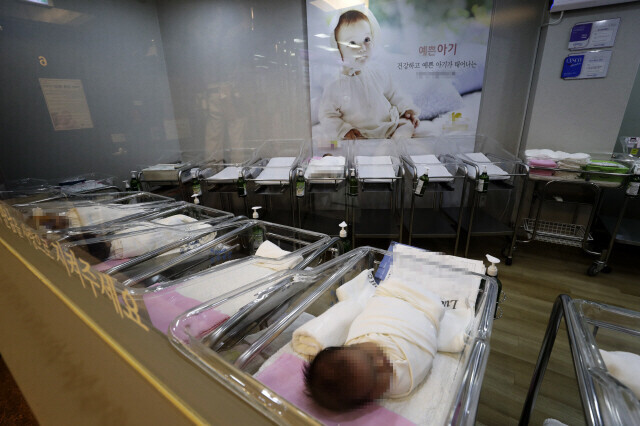hankyoreh
Links to other country sites 다른 나라 사이트 링크
S. Korea’s fertility rate marks record low in 2020

Last year, South Korea’s total fertility rate dropped to 0.84, which was once again the lowest rate on record. The Korean population has also begun to naturally decline for the first time, with the number of deaths exceeding the number of births. There has been a sharp drop in the number of marriages during the COVID-19 pandemic, fueling concerns that the number of births could shrink even further in the future.
Provisional figures for births and deaths in 2020 published by Statistics Korea on Feb. 24 show that the country had a total fertility rate of 0.84 last year, down 0.08 from 0.92 in 2019. That rate represents the average number of children that a woman is expected to have over the course of her life.
The birth rate dropped below 1 for the first time in 2018, when it reached 0.98; last year, it fell below 0.9.
The decline in childbirth is continuing to pick up speed, with the birth rate hitting 0.75 in the fourth quarter of the year. The rate was particularly low in big cities such as Seoul (0.64) and Busan (0.75), where young people and unmarried people make up a large share of the population.
South Korea’s total fertility rate was the lowest of any country in the world. In 2018, Korea was the only one of the 37 member countries of the Organisation for Economic Cooperation and Development (OECD) to have a birth rate below 1 (0.98). The average rate in OECD member states was 1.63.
There were 272,400 babies born in South Korea last year, down 10% from 2019 (302,700). The annual number of childbirths fell below 300,000 just three years after first falling below 400,000 in 2017.
Korea reported 305,100 deaths last year, outnumbering childbirths by 32,700. That marked the first occurrence of natural population decline, in which there are more deaths than births.
“Since there were fewer marriages last year because of COVID-19, the number of births could decrease even more, while the number of deaths will continue to increase because of population aging. That means the natural population decline could speed up a little,” said Kim Su-yeong, chief of Statistics Korea’s vital statistics division.
The Korean government recorded 213,513 marriages last year, down 10.7% year on year.
The pattern of population decline closely mirrors the most pessimistic of several population forecasts published by the government two years ago. In a special long-term population projection published in 2019, Statistics Korea estimated that the country’s total fertility rate would be 0.86 in 2021, while offering 0.78 as a more pessimistic alternative projection. Last year’s birth rate (0.84) was already below statisticians’ prediction for this year.
A lower birth rate accelerates societal aging, leading to a sharp increase in welfare spending on old-age pension and medical expenses. At the same time, a decrease in the working-age population weakens economic growth and depresses fiscal revenue.
Two years ago, the government promised to set up a population policy task force that would work on long-term measures for dealing with the declining population. But so far, those efforts haven’t had any noticeable results.
Lee Sam-sik, a professor at Hanyang University, addressed that issue last year in a report titled “Changes in South Korea’s Population Policy and Implications of the Era.”
“In addition to micro-level approaches such as paying subsidies, there needs to be an effort to resolve fundamental issues in our society and culture, including the gender inequality in our system of labor and the assumption that workers should sacrifice their family life,” Lee wrote.
By Lee Kyung-mi, staff reporter
Please direct comments or questions to [english@hani.co.kr]

Editorial・opinion
![[Guest essay] The real reason Korea’s new right wants to dub Rhee a founding father [Guest essay] The real reason Korea’s new right wants to dub Rhee a founding father](https://flexible.img.hani.co.kr/flexible/normal/500/300/imgdb/original/2024/0423/8317138574257878.jpg) [Guest essay] The real reason Korea’s new right wants to dub Rhee a founding father
[Guest essay] The real reason Korea’s new right wants to dub Rhee a founding father![[Column] ‘Choson’: Is it time we start referring to N. Korea in its own terms? [Column] ‘Choson’: Is it time we start referring to N. Korea in its own terms?](https://flexible.img.hani.co.kr/flexible/normal/500/300/imgdb/original/2024/0423/3617138579390322.jpg) [Column] ‘Choson’: Is it time we start referring to N. Korea in its own terms?
[Column] ‘Choson’: Is it time we start referring to N. Korea in its own terms?- [Editorial] Japan’s rewriting of history with Korea has gone too far
- [Column] The president’s questionable capacity for dialogue
- [Column] Are chaebol firms just pizza pies for families to divvy up as they please?
- [Column] Has Korea, too, crossed the Rubicon on China?
- [Correspondent’s column] In Japan’s alliance with US, echoes of its past alliances with UK
- [Editorial] Does Yoon think the Korean public is wrong?
- [Editorial] As it bolsters its alliance with US, Japan must be accountable for past
- [Guest essay] Amending the Constitution is Yoon’s key to leaving office in public’s good graces
Most viewed articles
- 1[Guest essay] The real reason Korea’s new right wants to dub Rhee a founding father
- 2Terry Anderson, AP reporter who informed world of massacre in Gwangju, dies at 76
- 3Why Korea shouldn’t welcome Japan’s newly beefed up defense cooperation with US
- 4[Column] ‘Choson’: Is it time we start referring to N. Korea in its own terms?
- 5Senior doctors cut hours, prepare to resign as government refuses to scrap medical reform plan
- 6Opposition calls Yoon’s chief of staff appointment a ‘slap in the face’
- 7[Column] The clock is ticking for Korea’s first lady
- 8New AI-based translation tools make their way into everyday life in Korea
- 9[Editorial] Japan’s rewriting of history with Korea has gone too far
- 10[Column] Are chaebol firms just pizza pies for families to divvy up as they please?